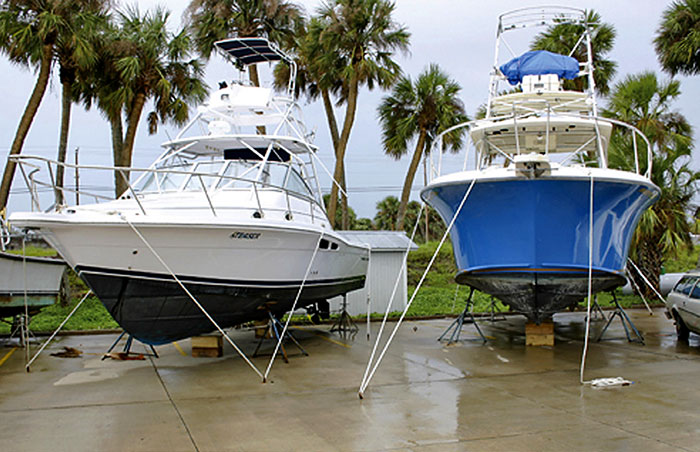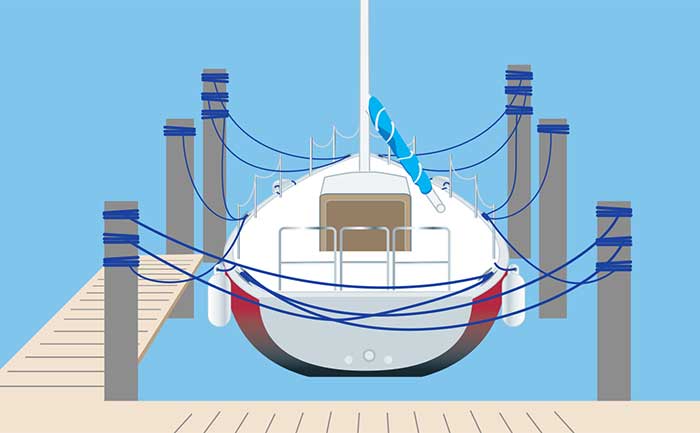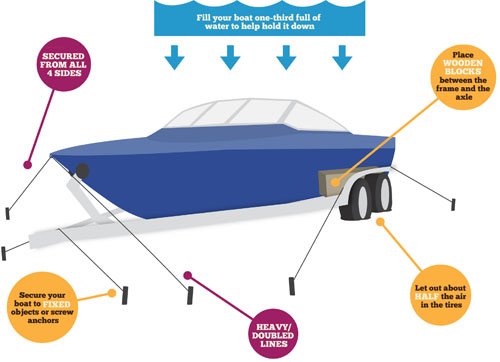When a hurricane is on the horizon, properly securing your boat becomes a top priority. It is critical to follow best practices to prevent significant damage to your vessel and minimize your risk. A hurricane brings with it not only strong winds and surging water but also rapidly changing conditions, so preparedness and adaptability are key. Here are essential steps to protect your boat, taking into account boat type, forecasted conditions, and dock type.
Before Creating a Hurricane Preperation Plan
If you own a boat, the first step in creating a hurricane preparation plan is to carefully review your marina’s contract. Look for any clauses that may require you to take specific actions when a hurricane is approaching. If you are new to your marina, it is smart to check in with the marina manager to understand the marina’s hurricane contingency plan and what measures they will take to protect boats during a storm. This ensures you’re aware of both your responsibilities and the marina’s procedures, allowing you to coordinate your efforts effectively.
1. Understand the Forecast: Wind Directions and Water Levels
Hurricane forecasts provide critical information about expected wind directions and water levels (storm surge). This data is essential for positioning your boat and determining how to secure it.
- Wind Direction: Forecasted wind directions help you anticipate how your boat will be impacted. For example, winds blowing offshore in the early stages of a storm might reverse direction as the hurricane passes. Make sure to account for changing wind directions by tying lines in multiple directions to prevent your boat from being blown against docks or other vessels.
- Water Levels: Storm surge and water levels can fluctuate dramatically during a hurricane, especially in coastal areas. In some cases, the water level may rise 10 feet or more. Preparing for these water level changes is crucial to ensuring that your boat remains secure and doesn’t float over dock pilings or get submerged.
2. Dock Factor: Fixed vs. Floating
Where and how you dock your boat can influence how you secure it before a storm.
- Floating Docks: Floating docks offer more flexibility during storm surges, as they rise and fall with the water. Boats on floating docks are less likely to break free from their moorings during high surges. However, extra precautions should still be taken to prevent chafing, and extra fenders should be used to prevent the boat from being damaged by the dock or other boats.
- Fixed Docks: Fixed docks can be more problematic in hurricanes due to their inability to rise with storm surges. When securing your boat at a fixed dock, allow for significant vertical movement by using longer dock lines (known as storm lines). Ensure the lines have enough slack to accommodate rising water levels but are secure enough to keep the boat from drifting too far.

3. General Best Practices for Powerboats and Sailboats
Powerboats and sailboats have different considerations due to their shape, weight distribution, and attachment points. Here’s what to keep in mind for both:
Powerboats
- Remove and Secure Items: Before the storm arrives, remove or secure loose items such as cushions, antennas, fishing equipment, and canvas covers. These items can easily become airborne in high winds.
- Reduce Windage: Anything that catches wind, such as biminis, dodgers, dinghies, and outboard motors, should be removed or tightly secured. Reducing windage helps minimize the force on your boat’s moorings or dock lines.
- Double Up on Lines: Use extra lines to tie down your powerboat, ideally doubling the number of lines you would typically use. Attach lines to sturdy points on the dock and boat cleats, and cross the lines in an “X” pattern to add stability. Be sure to use chafe protectors where lines rub against cleats or edges.
- Check your bilge pumps and ensure batteries are fully charged. It is likely your marina won’t have shore power if there’s a direct hit.
- Check Mooring or Anchoring: If mooring the boat, make sure the mooring is designed for storm conditions, as standard moorings may not withstand a hurricane. If using anchors, set multiple anchors in different directions for added security. Ensure the lines have appropriate chafe guards and that the anchor points are sound.
- Consider Hauling Out: If possible, haul out smaller powerboats to a dry dock or yard well in advance of the storm. Boats on trailers should be parked away from flood-prone areas and secured to the ground if possible.

Sailboats
The above items remain true for sailboats. In addition:
- Remove or Secure Sails and Rigging: Take down any removable sails, especially headsails and furling jibs, which can catch wind and cause damage. Make sure halyards and lines are tightly secured to prevent them from whipping around in the wind. Using an extra line, wrap your mainsail bag around and around, securing it to the boom.
- Note that many insurance companies will deny claims if you leave sails on, particularly roller furling ones.

4. Additional Tips
- Fenders: Use plenty of fenders to protect your boat from banging into the dock or other vessels. Ensure fenders are placed at key impact points.
- Chafing Gear: Protect your lines from chafing by using chafe guards or wrapping the lines at critical points where they might rub against edges, pilings, or cleats.
- Check and Recheck: Once your boat is secured, regularly check the forecast and your boat’s position until it’s unsafe to go outside. Boats can shift unexpectedly as conditions change, so an early check allows for adjustments.
5. What If My Boat Is On The Hard?
In most cases, boats that are hauled out of the water tend to fare significantly better during hurricanes than those left in the water. This is especially true in areas vulnerable to high storm surges, where boats at docks or moorings are exposed to rising water levels, strong winds, and debris. For many boat owners and marinas, hauling vessels is a cornerstone of their hurricane preparedness strategy. The process of hauling a boat out of the water and securing it on land, whether in a dry storage facility or on sturdy cradles, reduces the risk of damage from floating debris, chafed lines, and violent wave action.
Forward-thinking marinas and yacht clubs often implement evacuation protocols to pull as many boats out of the water as possible when a storm is imminent. These facilities have specialized equipment, such as travel lifts and hydraulic trailers, and trained staff ready to execute a well-coordinated plan. In some cases, marinas offer priority hauling services for annual members or vessels over a certain size, ensuring that boats are moved to safety before the storm hits.
However, it’s important to recognize that hauling out boats is a time-intensive process, and once a storm warning is issued, the window for action begins to narrow quickly. This means boat owners must make early, decisive calls regarding their hurricane strategy. Waiting too long can result in limited availability of hauling services, or worse, leave you scrambling for alternative ways to secure your boat.
To ensure your boat is hauled out in time, plan ahead. Coordinate with your marina or boatyard well in advance of hurricane season, confirm availability, and be prepared to act quickly when a storm threatens. Once your boat is on the hard, it still needs to be secured properly. Remove any valuable electronics and other gear, as high winds or floodwaters can still cause significant damage. Boats on trailers should be moved to the highest ground / safest possible location, then have the trailer tied down and blocked up to prevent movement. If your boat is on stands, ideally they are all level and don’t allow for any movement. Note that in a tight boatyard setting, surrounding boats falling over can be just as much of a risk to your boat.

Conclusion
Preparing your boat for a hurricane requires a thoughtful approach that considers the type of vessel, forecasted conditions, and your docking arrangement. Powerboats and sailboats each have unique needs, but the core principle remains the same: be proactive, secure your vessel in multiple directions, and account for wind and water level changes. By taking the time to secure your boat properly, you significantly increase the chances of it surviving the storm with minimal damage.
Remember, safety comes first. If evacuation orders are issued or conditions become too dangerous, prioritize your personal safety above all else. Your boat can be repaired or replaced—your life cannot.
